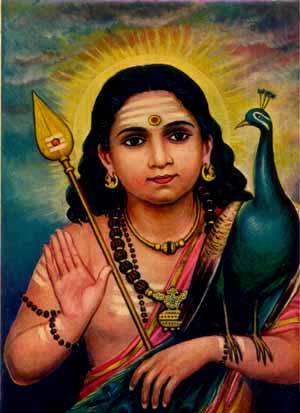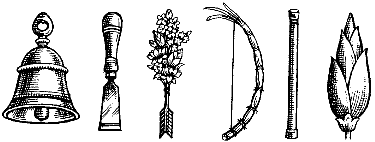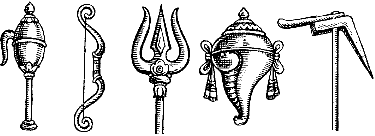Devotion to Murukan
by J.I. McGrath
Doctrines
| |
 |
|
Śrī Jñāna Pandita: Murugan as Expositor of Gñosis with His symbols the Vēl or Spear of Wisdom and vehicle/totem the peacock = Phoenix. Behind Him dawns the rising sun symbolising the awakened mind (bodhi). |
Worship of Murukan is an eclectic cult reflecting centuries of cultural synthesis. Murukan is not the god of a single culture. On a basis of Tamil religion he has integrated Saiva and Vaishnava attributes. He is a Tamil hill god that spread to the coast and the towns and then became the son of Śiva as Skanda. He is also known by the names of Kumāra, Subramanya, Kārttikeya, and Velan. The history of Murukan is the history of South India.
Murukan is a manifestation of teyvam, Tamil for the Divine, for his devotees. Other Tamil terms to describe him range from the abstract to his concrete symbols. For some he is a personal being. There is a face of Murukan for everyone. Indeed, the contemporary mythology of Murukan caters for all human needs and emotions.
With the development of Saivism in South India the school of Saiva Siddhanta emerged and this philosophy has been summarized in the fourteen Siddhanta sastras in Tamil. Of these the Śivanyana Potam by Meykanta Teva and the Śivanana Siddhiyar of Arulnanti Śivācārya are the clearest expositions. Such works combined the Sanskrit and Tamil elements. The religion of Saiva Siddhanta and Tamil bhakti is more to be experienced than metaphysical, thus affirming the early Tamil religion. The Tamil renaissance has continued this form of worship.
Murukan is called tamil kadavul, the "god of Tamil." His mythology is based on Tamil Nadu. He combines the Sanskrit and Tamil polarities of creation and destruction, symbolizes eternality, is the Lord of Time, and is closely related to the moon. The word muruku means honey, beauty, fragrance, divine music, eternal youth. It has even been suggested there is a link with the Dionysian cult coming into India with Alexander. Murukan's two consorts, the heavenly Devasena and the earthly Valli, fuse Saiva and Vaishnava motifs, and with them on the celestial mountain of Kanta Matanam he protects the universe. He destroys the asura (demon) Taraka. And he teaches his father Śiva the meaning of the sacred sound om.
Of great doctrinal importance are the six pilgrimage centres which are "topocosms" that "sacralize" Tamil Nadu. These are Palani, Tiruchendur, Tiruttani, Tirupparankunram, Swāmimalai, and the sixth is Kunratal, 'every hill on which the god dances,' that is, every other Murukan shrine.
| History
| | Early Tamil religion was celebratory with an aura of sacral immanence, seeing the sacred in vegetation, fertility, and the colour of the land. Murukan was a god of the hills and hunting, who fought evil in the hills, especially the cur who seeks to possess girls. The most important religious experience was possession by the god in an ecstasy. In the hills maidens with garlands danced intoxicated with the priests of Murukan.
After three centuries - the fourth to the seventh - of Buddhist and Jain dominance came Hinduization with the Tamil land - southernmost India - as the main centre of Hindu civilization. Murukan became identified with Skanda, son of Śiva.
The Tamil bhakti (devotional) poets from the seventh century reaffirmed early Tamil religion and Murukan was praised by Arunakirinatha in the fifteenth century and Kacciyapaciva in the seventeenth. From 1550 to 1750 temples to Murukan proliferated, especially in the west of the region, and were the settings for marriages and great festivals such as the Cittarai festival in Madurai. In the seventeenth century came the Tamil version of the Skanda Purana with all his Tamil background.
From the nineteenth century there has been a Tamil renaissance prompted by the discovery of Tamil culture by Western scholars. Clothey describes Tamil religion in the modern era as "neo-bhakti" with numbers at festivals and on pilgrimages increasing dramatically, temples being renovated and welcoming all strata of society from the 1920's. Murukan has become enormously popular because he attracts all levels of people and because he represents Tamil antiquity and identity and unites so much of the symbolism of Tamil religion (Clothey in Eliade, Vol 14, 260).
| Symbols | | Murukan is associated with the number six, having six faces, six parents, and six pilgrimage centres. Each of the faces symbolizes one of the six qualities of the god: felicity, fullness, immortal youth, endless energy, protection from evil, and spiritual splendour. Together they imply divine totality. The god also harmonises with man who has six cakras and is a microcosm. The temple too is a microcosm with six cakras. The six pilgrimage centres represent "a mandala by which Tamil Nadu is itself cosmicized and breakthrough from the cosmos to transcendence is believed possible" (Clothey 1978, 177).
Murukan is commonly shown with a red face, except on stone statues, and is associated with gold. Red symbolizes the vibrant fertile earth as well as the anger of Murukan with blood dripping from his lance and the tusks of fighting elephants with which he is associated. The red cock is an animal of the god. Red and gold or yellow seem interchangeable. Red and yellow flowers denote the god and his dress is a mixture of gold and red. These colours symbolize the sun and the sacrificial fire. He is sometimes shown as a red lotus, for in some myths he is born of a lotus, symbolizing his primordial power.
The peacock is the most important animal in Murukan symbolism. The colour and fertility of the bird equated with the vibrant hills and its beauty was like that of women and fresh vegetation. The peacock danced in the rain and so brought rain like Murukan did. Peacock feathers decorated the kuntu, small pillar, used in worship, and the lance of war and worship. Later the peacock became the mount of Murukan and flew around the world and to the heavens. When the peacock holds a serpent in claws or beak, this symbolizes its control of malevolent cosmic forces. By the medieval period the peacock is also a symbol of the ocean. As a cosmic symbol the peacock represents totality as does Murukan.
The cock and elephant are also important animals with Murukan. Of minor importance are the ram, goat, horse, and serpent.
Murukan's weapon is the lance, commonly the leaf-shaped Tamil vel, sometimes the Sanskrit sakti. The priest of Murukan is the velan, a bearer of the lance. When Murukan holds the lance as sakti, he and his lance symbolize Śiva-Śakti, the cosmic pair, god and soul, heaven and earth, god and world. The two extremes of the cosmos, earth symbolized by the peacock and primordial sound symbolized by the cock, are held together by the lance.
Murukan is worshipped with water, coconut milk, sandal paste, red millet, honey, rice, blood, and red, yellow, or white flowers.
There has been remarkable persistence in the symbols of Murukan over the centuries.
| Adherents | | Millions worship Murukan, especially in Tamil Nadu. More than two million pilgrims visit Palani temple each year and it is second in wealth in the South only to Tirupati. More than a million pilgrims come to Tiruchendur in a year (Clothey 1978, 118,121).
| Centres | | Map of ancient centres of worship
Aru Padai Veedu | Palani | Tiruchendur | Tiruttani | Katirkamam
|
|



